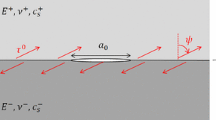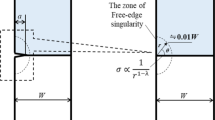Abstract
A numerical procedure, incorporated with the finite element solutions, is developed to evaluate the energy flux vector for a crack located along the interface of 2-D hyperelastic bimaterial solids. The formulation is considered with finite strains for use with both linear and nonlinear material behavior. The formulation is verified to be path-independent in a modified sense and so the near-tip region, where singular mechanical behavior dominates, is always included. Special attention is hence addressed on appropriate modeling of the singular behavior. The numerical results show good accuracy without using any particular singular finite elements.
Similar content being viewed by others
References
Chang, J.H. and Pu, L.P. (1997). A finite element approach for J 2 calculation in anisotropic materials. Computers & Structures 62(4), 635–647.
Chang, J.H. and Yeh, J.B. (1997). Calculation of J 2-integral for 2-D cracks in rubbery materials, Engineering Fracture Mechanics, to appear.
Comninou, M. and Schmueser, D. (1979). The interface crack in a combined tension-compression and shear field. Journal of Applied Mechanics 46, 345–348.
deLorenzi, H.G. (1982). On the energy release rate and J-integral for 3-D crack configurations. International Journal of Fracture 19, 183–193.
Duan, S., Yazaki, H. and Nakagawa, K. (1989). A crack at the interface of an elastic half plane and a rigid body. Engineering Fracture Mechanics 32, 573–580.
Eischen, J.W. (1987). An improved method for computing the J 2 integral. Engineering Fracture Mechanics 26(5), 691–700.
Erdogan, F. (1963). Stress distribution in a nonhomogeneous elastic plane with cracks. Journal of Applied Mechanics 30, 418–423.
Eshelby, J.D. (1974). Calculation of energy release rate. Prospects of Fracture Mechanics 69–84.
Geubelle, P.H. and Knauss, W.G. (1994a). Finite strains at the tip of a crack in a sheet of hyperelastic material: I. Homogeneous case. Journal of Elasticity 35, 61–98.
Geubelle, P.H. and Knauss, W.G. (1994b). Finite strains at the tip of a crack in a sheet of hyperelastic material: II. Special bimaterial cases. Journal of Elasticity 35, 99–137.
Hellen, T.K. and Blackburn, W.S. (1975). The calculation of stress intensity factors for combined tensile and shear loading. International Journal of Fracture 11, 605–617.
Hermann, J.M. (1989). An asymptotic analysis of finite deformation near the tip of an interface crack. Journal of Elasticity 21, 227–269.
Herrmann, A.G. and Hermann, G. (1981). On energy release rates for a plane crack. Journal of Applied Mechanics 48, 525–528.
Knowles, J.K. and Sternberg, E. (1972). On a class of Conservation laws in linearized and finite elastostatics. Archive for Rational Mechanics and Analysis 44, 187–211.
Knowles, J.K. and Sternberg, E. (1983). Large deformations near a tip of an interface crack between two neo-Hookean sheets. Journal of Elasticity 13, 257–293.
Rice, J.R. (1988). Elastic fracture mechanics concepts for interfacial cracks. Journal of Applied Mechanics 55, 98–103.
Stephenson, R.A. (1982). The equilibrium field near the tip of a crack for finite plane strain of incompressible elastic materials. Journal of Elasticity 12, 65–99.
Williams, M.L. (1959). The stresses around a fault or crack in dissimilar media. Bulletin of the Seismological Society of America 49, 199–204.
Yamasaki, J., Yuuki, R. and Kitagawa, H. (1986). Fatigue crack growth properties along the interface of epoxy plates with different Young's moduli and evaluation of the bonding strength of the interface. Transactions of Japan Society of Mechanical Engineering A52-476, 963–971.
Author information
Authors and Affiliations
Rights and permissions
About this article
Cite this article
Chang, J., Yeh, J. Energy flux associated with a plane crack along an (hyper)elastic bimaterial interface. International Journal of Fracture 85, 211–229 (1997). https://doi.org/10.1023/A:1007481409715
Issue Date:
DOI: https://doi.org/10.1023/A:1007481409715




